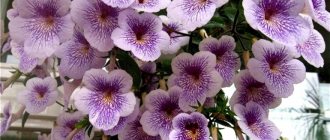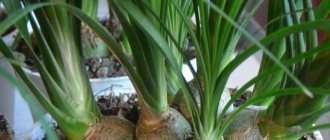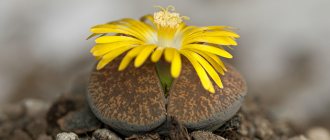The plant blooms from mid-summer to mid-autumn. It has unusual scalloped flowers with petals bent back. Gloriosa is native to the tropical zones of Africa. Found naturally in India. In Australia, Gloriosis is so widespread that it is considered a harmful weed that suppresses beneficial plants.
Also see how to grow chlorophytum at home.
| Average growth rate. Leaves grow over the course of a season. |
| Blooms from mid-summer to mid-autumn. |
| The plant is easy to grow. Suitable for a beginner. |
| Perennial. Dormant period in winter. |
Beneficial properties of gloriosa
Gloriosa is a poisonous plant. The aerial part and root of the flower contain the alkaloid colchicine, the minimum dose of which - only 0.006 g - can cause fatal poisoning. But homeopaths and pharmacologists derive benefit from toxic substances.
Colchicine, which affects the kidneys and has a detrimental effect on vision, in the right dose and in combination with the necessary components, prevents cell division and reduces the production of uric acid. When used correctly, the substance helps cope with the symptoms of gout and is used to prevent amyloidosis.
Using tubers
When babies appear, they are carefully cut off and transferred to containers 13-16 cm in diameter. The soil is prepared by mixing turf and leaf type soil, humus with sand in a combination of 1:2:2:0.5. The root crop has one growth point. It should be on top. Cover the tuber with a substrate 3 cm thick.
Home gerbera: how to grow and care for it correctly? 130 photos of flowers and tips for keeping them indoorsAchimenes: care, growing indoor flowers and tips on choosing them for planting (115 photos + video)
- Bathroom renovation ideas
The optimal growth regime will be 22-24°C. Water the young plant after young shoots appear. Support is provided for weak stems. As the root system develops, larger containers are selected.
Gloriosis: care at home. Briefly
It is difficult for a tropical plant to take root indoors. To help acclimatize at home, create a favorable environment for gloriosis:
| Temperature | In winter – no higher than + 15°C, in summer – from + 20°C. |
| Air humidity | Increased, from 65%. |
| Lighting | Diffused bright; windows facing west or east. |
| Watering | Do not water in winter; in summer water abundantly, in autumn - rarely and sparingly |
| Soil for gloriosa | Versatile floral; prepared from equal volumes of leaf soil, turf soil, and peat. |
| Feeding and fertilizer | During flowering, every 15 days, use mineral fertilizer diluted with water. |
| Gloriosa transplant | Young tubers are planted every spring. |
| Reproduction | Seeds and tubers. |
| Features of cultivation | When replanting a vine, they immediately install a support along which it will crawl. By installing the structure later, the tubers may be damaged and the stems may break. In winter, the plant needs rest. |
Temperature
The flower should be kept at 20-25°C. This mode is most suitable for the spring-autumn period. This is the time of active plant development. With the beginning of dormancy, the tuber is dug up; it must be kept in cool conditions at 12-15 ° C.
With the arrival of spring, the plant begins to come to life. Shoots appear on the tuber. Therefore, it is necessary to slowly and gradually increase the temperature. You can’t suddenly move it to a warm place or a hot room - this will have a detrimental effect on gloriosis.
Caring for gloriosa at home. Details
If you take care of the plant and care for it properly, you will be lucky to see its original flowering.
Gloriosa bloom
The flowering of domestic gloriosa is unusual and expressive.
Single drooping flowers are formed on long (up to 0.2 m) peduncles. The diameter of the flowers can reach up to 15 cm. The petals often have a two-color color (it can change during flowering) and a scalloped surface. In some species the petals are curved upward. Up to seven flowers are simultaneously formed on the shoot, which bloom in turn. Flowering occurs in summer. After it, a fruit is formed - a box with seeds.
Temperature
A tropical plant needs warmth. In order for gloriosis to develop well, home care requires controlling the temperature. The flower is kept in summer at a temperature of + 23 - 25°C. With the onset of autumn it is gradually reduced.
By winter, the mercury should drop to + 14°C. Do not allow sudden changes in temperature: the plant may die.
If you place a flower on the balcony in the summer, make sure that the gloriosa is protected from the wind.
Spraying
Gloriosa at home must be kept at high (55 - 70%) humidity. If the house is dry, the plant may not bloom. Air humidity is raised in different ways. Spraying is possible if Gloriosa does not bloom. During flowering, turn on humidifiers; An open container of water is placed next to the pot. A flowerpot with a flower is placed on a tray with wet pebbles.
Lighting
Gloriosa grows well and blooms brightly in bright, indirect light. Therefore, the container with the flower is placed on the east or west window. A window facing north is not suitable: not only is there little light there, but it is also dark. On the south window, on the contrary, it is very light.
Intense light can cause leaf burn.
Watering Gloriosa
Watering plants at home always raises many questions.
Gloriosa is considered moisture-loving, but waterlogging is extremely dangerous for it. It can withstand a short drought, but if the soil is 1/3 dry, it's time to water. Therefore, we must remember that Gloriosa needs moderate and timely watering. In summer, when the plant is actively developing and blooming, water more often and more abundantly than at other times. In autumn it gets colder and less water is needed. In winter, when the plant is resting, it is not disturbed. For irrigation, always use lukewarm, settled water. It is best to water in the evening or early in the morning: this way the moisture will be better preserved.
Gloriosa pot
The container is selected taking into account the characteristics of the plant and its dimensions. When buying a pot for gloriosa, you must remember that the plant will not bloom in a spacious container. Young nodules, separated from the mother tuber, are planted in pots whose diameter does not exceed 150 mm.
Next, the width of the flowerpot is selected taking into account the size of the tubers; height - taking into account the size of the planting material and the height of the drainage layer.
Priming
Gloriosa needs a breathable nutrient substrate that has a neutral degree of acidity. You can prepare the soil at home and make a soil mixture from equal parts of turf soil, peat and leaf soil.
You can buy universal primer for flowers in the store. Vermiculite, brick chips, and foam balls are added to any of the substrates at home to make it more loose.
Feeding and fertilizer
During the flowering period, Gloriosa needs fertilizing and fertilizers to prolong the process, increase the number of buds and give them greater brightness. The procedure is carried out every 15 days after evening watering (then the plant is shaded for a day).
Use universal mineral fertilizers containing large quantities of phosphorus and potassium (fertilizers must be diluted with water 2 times). In autumn and winter, fertilizing is not carried out.
Transfer
Every spring they transplant Gloriosa.
A thick layer of drainage and part of the substrate are poured onto the bottom of the pot. Young tubers are fragile. They are separated from the mother plant and carefully, without dividing into parts, planted in a horizontal position. Planting is carried out so that the upper fragment of the tuber rises 25 mm above the ground. Install the support. Water the plant. Wait for the water to be absorbed and the soil to settle slightly. After this, add a little soil.
After planting, the plant is placed in the shade for 7 days. After 2 weeks they begin to feed.
Trimming
Gloriosa does not need pruning. The procedure does not affect the branching of the plant, but has a bad effect on flowering. Gloriosa flowers form on the tips of the shoots. Having cut them, you will have to wait a long time for flowering: a lot of time must pass for the plant to recover.
Rest period
Flowering - so original and bright - tires gloriosa. Therefore, the plant vitally needs a period of rest, which it openly declares by shedding its leaves. Leafless shoots dry out. Young growth will appear again in the spring on the surviving tuberous root. You can leave the bare vine in a flowerpot in a shaded, dry place until the end of February, then replant it in new soil.
The optimal winter temperature will be + 15 degrees. The second option is that after the vine dries, the tuber is removed from the soil. Cover it with sand or peat on all sides and store it in paper packaging at + 13 degrees. In early March, the tuber is planted in the substrate.
In this case, seedlings will appear later than when planting a potted vine. Gloriosis observes a period of rest from the second year of life. The young vine does not dry out during the winter; it is left in a pot in a cool place.
prop
Gloriosa is a vine. A plant can develop correctly and look beautiful if it has support. Nature, helping the flower, “decorated” the tips of its upper leaves with tendrils. With their help, gloriosa clings to support, protecting thin shoots and delicate flowers from fractures.
There are no tendrils on the lower part of the shoots, so a support is installed in the form of bamboo sticks, ladders with narrow rungs, a net or a tightly stretched rope, or fishing line. The most important thing is that the support must be thin so that small antennae can catch on to it.
The support is installed very carefully so as not to break the graceful shoots.
Lighting
Gloriuosa loves bright light, so she needs to create conditions with good lighting. True, the best option would be to place it on window sills with an eastern or western orientation. If you place it on windows facing south, then the midday sun can be harmful. Shading can cause stretching of shoots and lack of flowering.
Reproduction of Gloriosa
At home, Gloriosa is propagated in two ways.
Growing Gloriosa from seeds
The lesson is long, the result does not always coincide with expectations. The seeds have low germination; seedlings develop with difficulty. A day before planting, the seeds are soaked in a solution of a growth stimulator. Planted in the ground, deepening by 0.5 mm. Cover with film and germinate in a warm place at + 23°C. Ventilate the seedlings daily; water when the soil dries out. You will have to wait about a month for germination. When 2 pairs of leaves are formed, the strengthened plant is replanted.
Reproduction of Gloriosa by tubers
The method of propagating gloriosa by tubers is used more often: it is more effective. Small, fragile tubers are carefully separated from the adult mother plant. They are planted in a loose soil mixture, pointing the growth point upward. Immediately install a support so as not to damage the tubers later. Sprout with lower heating without watering. Watering begins when the shoots appear. The grown plant is transplanted into a large container.
A plant obtained from seed will bloom in about two years. It will not retain the varietal properties of the mother plant.
Providing peace
As soon as the leaves begin to turn yellow in September and the stems dry out, watering should be stopped. This is how the plant signals the transition to the dormant stage. With good watering of the flower, the tuber turns out to be large. The root crop is stored as follows:
Without removing it from the substrate, you should place the pot in a dark place. The temperature should be room temperature. Avoid proximity to heat sources. Replanting into new soil should be done in February or in the first ten days of March. The speed of revival is 2 weeks.
The tuber is removed from the substrate and placed in peat placed in a box for the autumn-winter season. You can also use well-dried sand. The container is tightly closed and transferred to the refrigerator at 8-12°C.
Diseases and pests
If gloriosa is not cared for conscientiously, it may develop diseases, and it will be easier for pests to attack a weak plant. Trouble manifests itself in the form of different symptoms:
- Gloriosa bulbs rot - a consequence of waterlogging (the tuber is cleaned of damage, treated with a fungicidal agent and sprinkled with coal powder; if this happens in winter, the tuber is left for storage; at other times, it is planted in the ground);
- the leaves drooped and lost turgor - a sign of root rot from excess moisture;
- Gloriosa does not bloom - lack of light, a spacious pot, damage to the tuber due to improper storage (move to a bright place; transplant into a tighter pot; try sprinkling with charcoal powder or smearing with aloe juice, dry and plant);
- leaves turn pale - there is not enough light (move to a brighter place);
- Gloriosa leaves have darkened - due to sharp temperature fluctuations, drafts (move to a place protected from the wind);
- gloriosis grows slowly - sudden change in temperature;
- Gloriosa leaves turn yellow - due to low air humidity (spray if Gloriosa does not bloom; place on a tray with wet pebbles);
- white coating on the leaves - from watering with hard water (settle the water, sometimes add citric acid or lemon juice to it - 0.2 g or 3 drops per liter of settled water).
Often a weakened plant is affected by spider mites, scale insects, and aphids. The pests are washed off with a shower, and the plant is treated with an insecticide.
Humidity
The plant is moisture-loving, so increased air humidity parameters are desirable. For this, both standard humidifiers and trays with moistened moss are used. You can put pebbles or expanded clay in the trays along with water.
Spraying should be done regularly. Soft water is suitable. Its temperature should be close to room temperature. Spray carefully during flowering - water should not come into contact with the buds that have blossomed. Otherwise, there is a high risk of losing flowers.
Types of Gloriosa domestica with photos and names
In the natural environment, different types of gloriosis occur. At home, one species and its varieties are mainly common.
Gloriosa luxurious, or magnificent (Gloriosa superba)
Long (up to 200 cm) vine with thin shoots. Pale green leaves have a shiny surface. Their length reaches 100 mm, width – 30 mm. The tip is pointed. Flowers with long (up to 80 mm) scalloped petals with a peculiar color are formed in the axils of the leaves: on the outside they are salmon-colored with a pink tint. The inner side is scarlet on top, golden on the bottom. Blooms all summer.
Popular varieties
The most common varieties of luxurious gloriosa are:
Luxurious yellow Gloriosa (Gloriosa Lutea)
Low-growing (up to 0.9 m) plant with bright lemon flowers.
Gloriosa Carsonii
A low plant with flowers of double color: violet-brown petals with a golden edge.
Gloriosa Luxurious Grena (Gloriosa Greenii)
The surface of the leaf plate is not scalloped, but absolutely smooth. Long (up to 85 mm) rich yellow petals, curled outward, look like lanterns.
Rothschild's Gloriosa (Gloriosa Rothschildiana)
The height of the vine exceeds 200 cm. The large flowers at the edges are rich lemon, in the center they are carmine red.
Gloriosa modesta (Gloriosa modesta)
Medium sized liana (less than 200 cm). The leaf blades are bright green in color. Large drooping flowers are yellow with an orange tint. Their surface is glossy.
The exotic tropicana is capricious and requires special care. Therefore, gloriosis is rarely found in apartments. If a flower is lucky with a caring and patient owner, it will not remain in debt and will repay with bright, unusual blooms.
Currently reading:
- Eucharis - home care, photos of species, transplantation
- Wallota - growing and care at home, photos of species
- Stefanotis - home care, photo. Can I keep it at home?
- Alocasia domestica. Growing and care
- Oleander
Planting seeds
This is a more labor-intensive method. First you need to pollinate the plant using a cotton swab. Once the seeds are collected, they should not be stored. Planting Gloriosa is done quickly. To do this, you need to take a substrate that includes peat with turf soil and sand in equal parts.
Planted seeds are kept in small greenhouses at 22°C and above. Regular ventilation is required. After the sprouts appear, they are thinned out, and then the seedlings are picked. Flowers form after 3 years.
Interesting Facts
- According to legend, a flower from the tropical zone of the Asian and African continents came to Europe thanks to the Queen of England. During her trip to Rhodesia, Elizabeth II was presented with a precious brooch in the form of a gloriosa. The flower I liked, by royal command, ended up in the British Isles, and then conquered the rest of Europe.
- In some parts of India and Thailand, the flower is so popular that it has become one of the elements of the state emblem. In Zimbabwe, the gloriosa plant has become a national symbol.
- Since ancient times, the poisonous properties of the flower were known to the natives, and they extracted juice from the tubers of the flower, and, like the character in Pushkin’s “Anchar,” they impregnated their arrows with poison.
- The flower is considered a wonderful gift for a man going to the battlefield. According to ancient beliefs, his presence brings good luck to warriors.
- In Australia, the flower adapted so well to local conditions that it began to reproduce with incredible speed, displacing endemic plants. The country is fighting it like a nasty weed.
Important! Despite all the attractiveness and beauty of the plant, if there are small children in the house who like to taste various indoor plants, growing Gloriosa is strictly prohibited. Pets can also suffer from the poison of the flower.
Botanical description
Gloriosa (lat. Gloriosa) lives in the tropical zones of Asia and Africa. The genus belongs to the Colchicum family and has 5-9 plant species. Initially, the genus belonged to the Liliaceae. The Gloriosa plant is a very ornamental plant. Gloriosa from the Latin Gloria - glory. It is a tuberous herbaceous perennial. The shoots are covered with leaves and curl. The leaves are arranged either in groups of three or opposite, elongated, lanceolate in shape, sessile. The flowers grow on long stalks that emerge from the leaf axils at the top of the plant.
Features of transplantation
Transplantation is necessary annually, in the spring. It is better to take a ceramic container for this plant, stable, wide and low. The soil is made from 4 parts of humus, 2 parts of deciduous soil and 0.5 parts of peat and sand. There is always drainage at the bottom of the pot to drain excess water.
A tuber that has overwintered in the sand is taken out and inspected for damage. When planting, it must be placed horizontally. You only need to cover the tuber 2-3 cm with soil. There is only one bud on the gloriosa tuber; if it dies, the sprout will not appear. The soil is moistened after planting. Acceptable temperature for crop germination is +15…+20°C. As soon as the stems appear, you can move the pot to a lighted windowsill where the gloriosa will grow.
Garter
Like any liana, the gloriosa indoor plant needs support. The stems of the plant are very tender and brittle. A garter to a support will help protect the stems from fractures during growth.
Important! The stakes for the garter must be thin so that the plant's tendrils can securely cling to them!
Watering
Like any plant, the tropical beauty requires water; without it, Gloriosa will die. In summer, the soil in the pot should be moderately moist. A large amount of moisture blocks the access of oxygen to the roots, and they can rot.
In autumn, the regularity of watering decreases, and after the leaves have fallen, the flower should not be watered.











